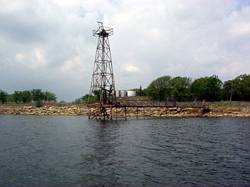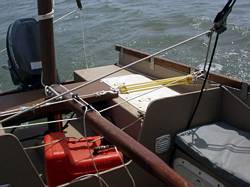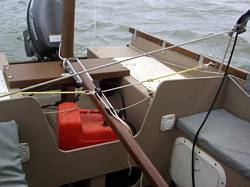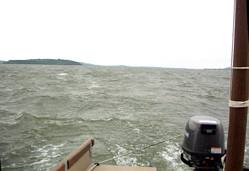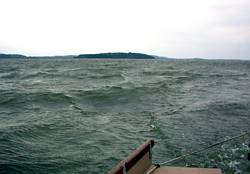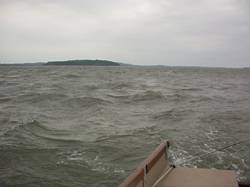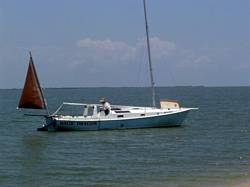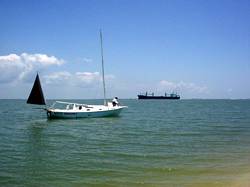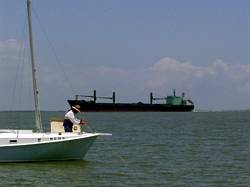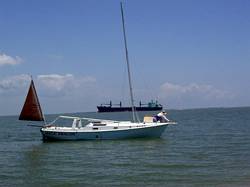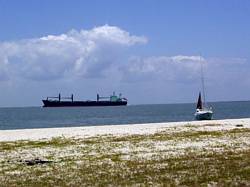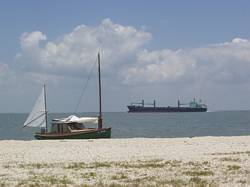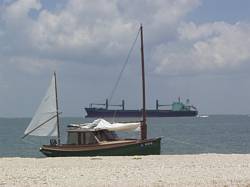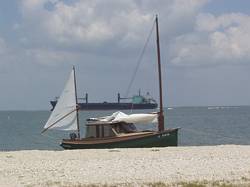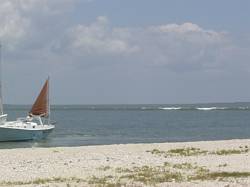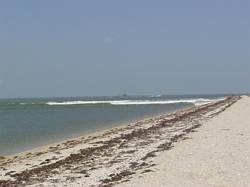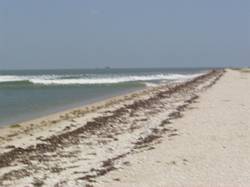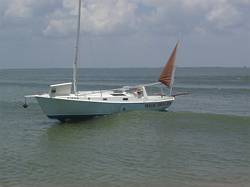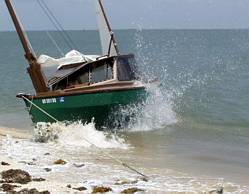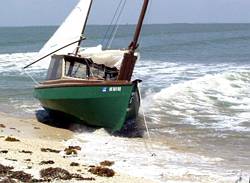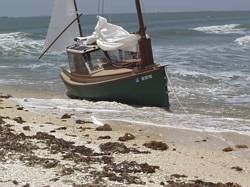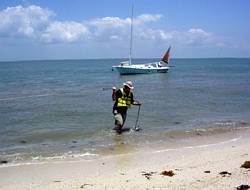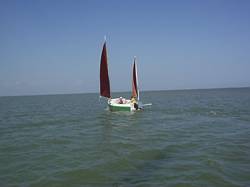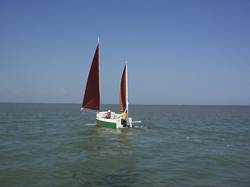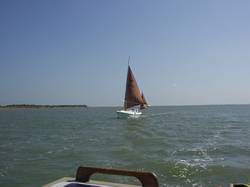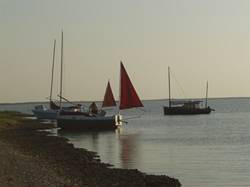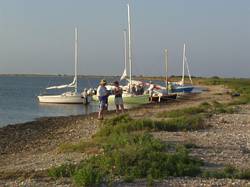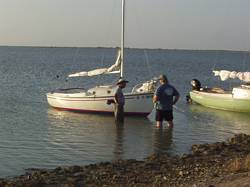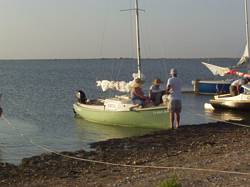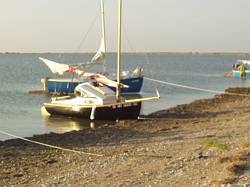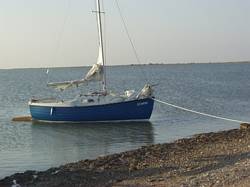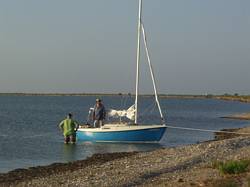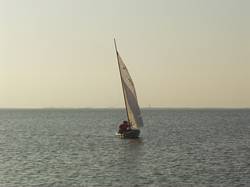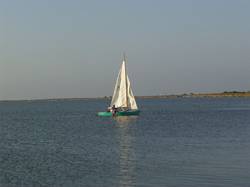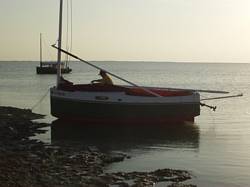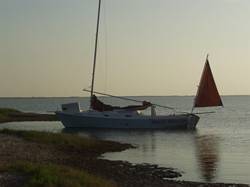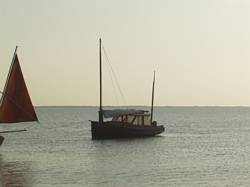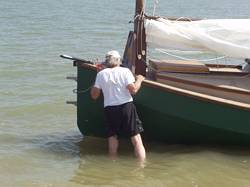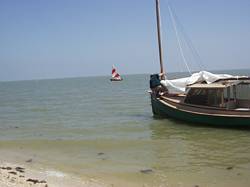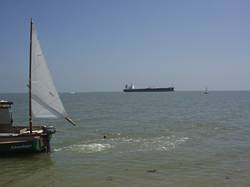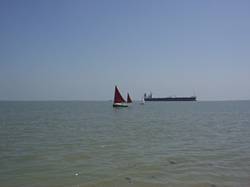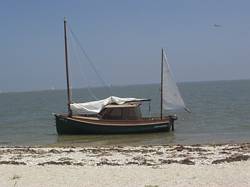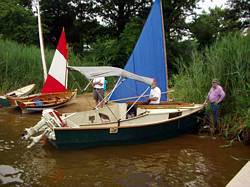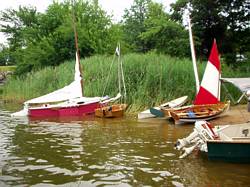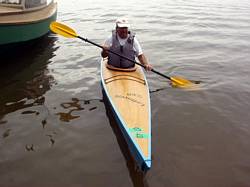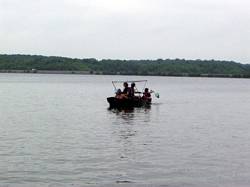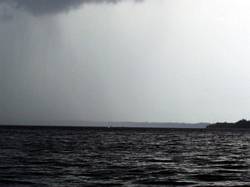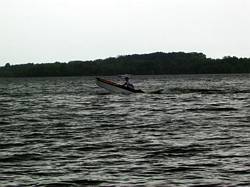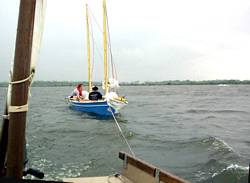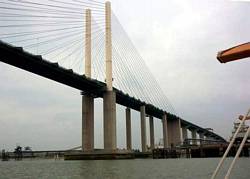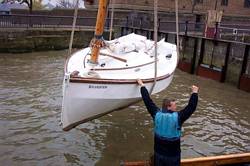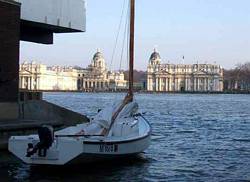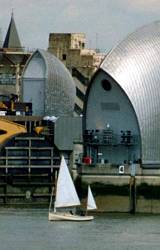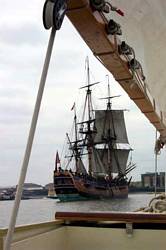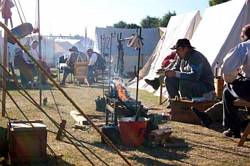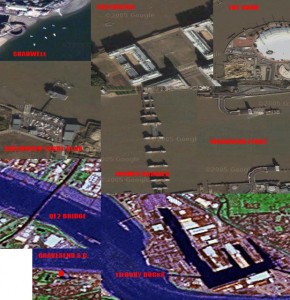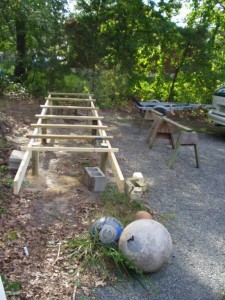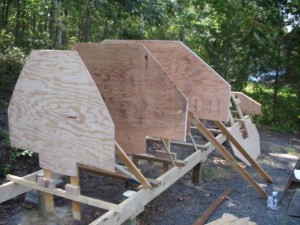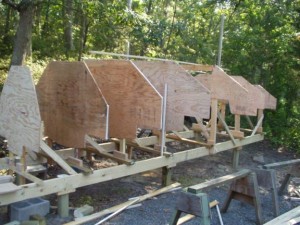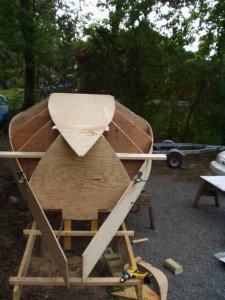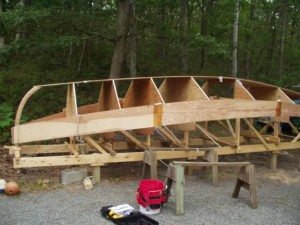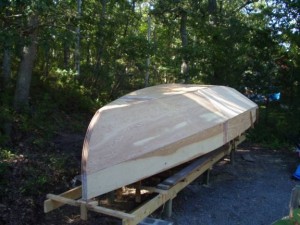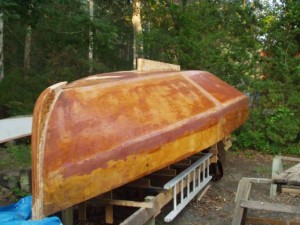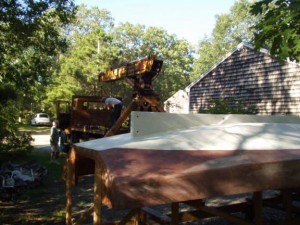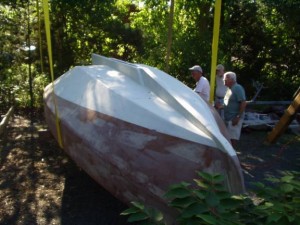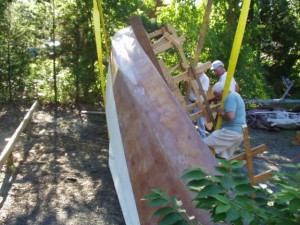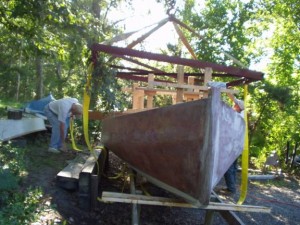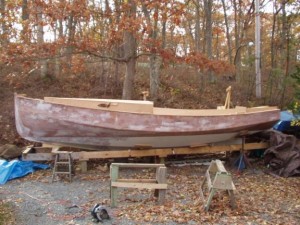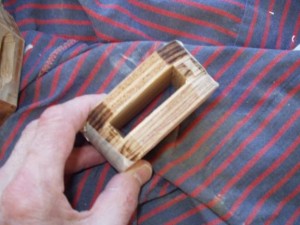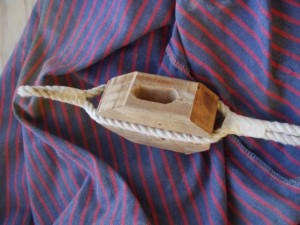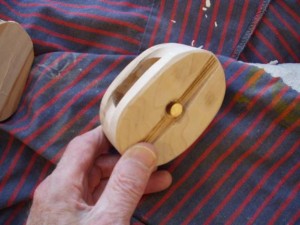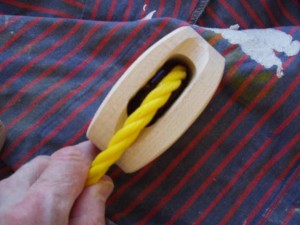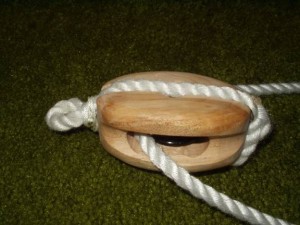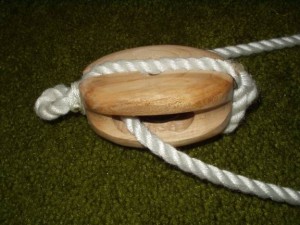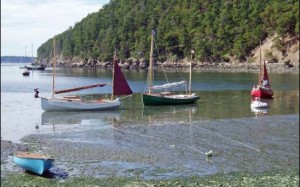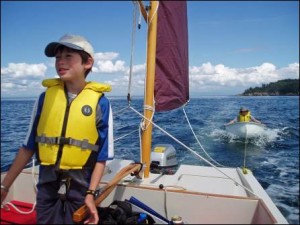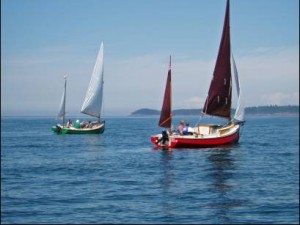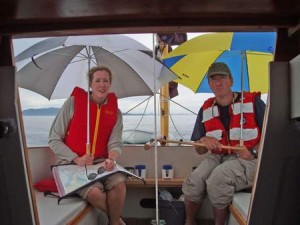News, questions, and boats for sale.
News:
| Been a busy summer for me, and apparently for everyone else as well. The last couple of months it’s just been too hot to go sailing, though I may make it out today.
Not a whole lot of contributions this issue, but the few we have are very good. Enjoy. Chebacco Richard |
Questions:
Chebacco’s for sale:
***
A Summer of Boating – Richard Spelling
In preparation for the much anticipated messabout in Port Lavaca, I decided it would not necessarily be a bad idea to check the boat and trailer out, before I towed them 1200 miles.
Matagorda Bay is a huge body of water, at least when compared to most inlandlakes, with about a 10 mile fetch for the prevailing wind to push up waves.
Anticipating larger waves on the trip than I was used to, I decided to give the boat a workout at the only local lake that even approaches the conditions in Matagorda Bay. Oolagah, north of Tulsa, has about a 10 mile fetch running north-south, and is famous in the area for good sailing. On the morning of the Oolagah trip, the weather man was predicting light winds, but I decided I would ignore him and go anyway.
When I got there the wind was absolutely perfect for the trial, a steady 14 knots directly from the north, right down the length of the lake. I have a hard time judging wave size, but it was rough enough for the flat bottom of the boat to drop off about every third wave. I sailed to windward for about 4 hours, going the 10 miles or so to the hiway bridge on the other end of Oolagah, slamming and pounding and splashing the whole way. Much fun.
While doing this, I experimented with sheet to tiller self steering systems for the Chebacco. I have reservations about using them on an unballasted boat, but I tried anyway. Not much success, the sheet didn’t want to move the tiller, even though I’d spent hours making sure it turned freely. Finally connected a bungee to both sides (see pic), and that worked, after a fashion. When the boat fell off, the hydrodynamic pressure on the rudder would push the tiller over, and the boat would head up. When it headed up too much, the bungees would pull the tiller over the other way, and the boat would head down. This setup maintained 4-4.5 knots for hours on end. While I could have sailed a bit faster by hand, I enjoyed sitting there and watching the tiller move on its own, relaxing, and drinking Budweiser.
The run back to the ramp was quite fun, and the boat got bounced around by the 2ft or so of chop. Enough chop that I got used to it, and built up more confidence in the boat– Which was kind of the whole reason for going out…
The GPS came in pretty handy, too, as I wasn’t familiar with this lake at all, and would have taken a couple wrong turns without it.
Pulling the boat out, the winch post on the trailer snapped at my weld… one of these days I’m going to learn how to do that right. Anyway, was able to get the boat back on by bracing the winch with some wood, and rewelded it when I got back to the house. Another good reason to take the boat and trailer on a “trial” sail, I guess.
Part of the trip prep was to see how well the wife’s mini van pulled the boat, to make sure we wouldn’t have any problems taking the van to Texas. I pulled it to Pryor with the F350, and then we swapped tow vehicles and towed it to Grand Lake, to meet a friend of the family.
The van towed and launched the boat just fine. We sailed around a bit in light air, and got a couple of admiring comments from people in quarter million dollar boats, then headed back to the ramp.
The van pulled the boat out just fine, but after I got out to make sure the boat was sitting right on the trailer, I couldn’t get back into the van! I must have hit the lock button or something when I got out. So, the van is sitting there blocking the ramp, with the trailer half in and half out of the water, engine running, and all doors locked. How annoying.
Mique, my wife’s friend, drove her back to the house to get the spare key, and I had to sit there and explain to everyone who wanted to use the ramp that they couldn’t, and why… The most generous comment I got was “It happens to the best of us!”
The trip to Lavaca was uneventful, with the exception of the three or so times I had to pull out the GPS to verify where we were. Some of the road signs in Texas are problematic…
At the last gas stop, in Port Lavaca itself, there was a smaller production sailboat and a guy with a British accent there. (Cortez 16, Noel Nicholls, ed) The wife was curious, so I sent her over to ask directions. Not because I couldn’t find the place (we had the GPS), but so she could talk to the guy. ( Note from Pat –He neglects to mention I warned him that he had to be nice to people with plastic boat because not everyone is privileged enough to have a wooden boat!)
Noel and another fella were there setting up their boats when we got to the ramp. I pulled in behind them, setup Schoedinger, and pulled around them to the ramp… while they stood there with open mouths…
As I sail up to the van and our chosen pagoda, some guy on a huge production boat says “Hi, Richard”. Hey, I recognize that voice! It’s Tom Cole, down from Texoma, with his Shearwater 28, the replacement for his Micro 19.
While Tom is setting up to take me for a ride in his new boat, a container ship comes into port. I grab the camera and start taking pictures, pretty neat, it passes really close to the beach…
Hey, is that a wake coming?
Well, shit.
No damage, but Pat says “After what I have just seen, I think my laptop will be safer in the van”
About the time for the Patagonia raid, Tom, George and I sailed over to Keller Bay to recon the area. Didn’t find a perfect spot, but the ocean side of the bay seemed to be doable. A very organic spot, with mussel clusters in the water, reeds in the salt marsh, etc. Very pretty, very nice. Then the sun set.
One thing I didn’t consider, of course, was that “organic”, and “marsh”, mean mosquitoes. While not any bigger than the variety in Oklahoma, they certainly were more numerous… And they thought that the inside of the windows in Schroedinger was a perfect place to spend the night.
Having been warned, we had netting to sleep under. However, they seemed to be getting through it. While this was probably just a combination of my imagination, the itch from the salt from the water, etc, it was enough to keep Alana and I up, which kept everyone else up. Finally, Pat says “Take me to a hotel”.(Note from Pat— Richard gave in FIRST. This was his trip and I was bound and determine to tough it out. I went outside and wrapped myself in mosquito netting, folded myself up and laid with my face over the side of the boat where it was cool. It really wasn’t all that bad for me, but there were some hot and itchy people complaining all night. I laid there thinking things like.. “I wonder how much he values his marriage” and “I wonder how Richard could get home if I just get in the van and leave.” Fortunately, he is a man that is smart enough to know that if he was miserable, I was even more miserable. He did suggest that we sleep on the beach but I vetoed that and paid for the hotel and then refused to camp the rest of the weekend. He was secretly relieved to come back at night to a shower and a dry, comfortable bed.)
Here, of course, is where the GPS really came in handy. Pitch black and an unfamiliar shoreline, there was basically no way we could have headed back without the GPS. We motored back to the beach, packed the boat up, and rented a hotel room.
Seeing as one of the things this trip was to do is see if I could take everyone on the boat on a trip, I would have to consider it a failure in that respect.
The next day was the messabout, which was quite fun. I even enjoyed being sociable, and seeing all the boats. I got to sail Tom’s Shearwater, and Chuck’s Ladybug, the latter bringing back all kinds of memories. (Note from Pat –Richard did seem to enjoy himself and the shrimp Mary cooked and the boudin that Tom brought made the meal memorable for me. The boxed wine helped with the whole trip as well, LOL)
Later in the afternoon I made the perfect anchoring maneuver– Almost. I sailed up to the beach, raised the board, and let the sheet out. Then I threw the bow anchor over the stern when the boat was about 150 feet from shore. It spooled out, dragged a bit, and set at a perfect distance to spin the boat around. When the stern of the boat was spun around it was only 10 feet from shore, so I threw the stern anchor onto the beach and headed up front to take in the slack on the bow anchor. Perfect. Except I forgot to cleat off the stern anchor, so the rope spooled out and went in the drink!
During the messabout, someone commented on the name of my boat, and that only about 20% of the people out there would get the joke. I told him that his figures were way off, that more like 2% got it…
That afternoon, I had another chance to ride a big wake. Here comes that same ship, dragging another wake behind it! I hop in my boat, and turn it into the wave, pulling on the well set anchor for five minutes as NOTHING happens. No wave. No wake. Not even a ripple. Go figure.
The trip back was relatively uneventful, we stopped and for lunch at a rest area, and met Mom for dinner when we passed her place.
The Midwest Messabout was only three weeks after Port Lavaca. Having learned my lesson from Lavaca, I took only one person with me to Rend lake. I had originally planned on driving there Thursday, but the transmission on my Tacoma went out and I spent Thursday putting a new one mostly in. Friday, Alana and I drove down in the spare truck.
It was almost dark when we launched, and the sun had set by the time we got to the messabout area. I visit for a bit, then proceed to set the anchors so we could get some sleep, so we could get up early in the morning.
Then, this guy comes over and says “Will you help me go find my bird?” Thinking I had misheard him, I reply “Excuse me?” “My pet parrot got loose, and it flew over the lake. Can we take your boat out and look for it?”
Well, how could I turn that down? So we headed out into the failing light, with this guy and his daughter standing in the forward hatch saying “Sweet Pea. Here Sweet Pea.”…
I would run the motor for a bit to build up some speed, then we would drift and they would call for their bird. Eventually, it was pitch dark, and we had found no bird, so we headed back. All this time I’m thinking that Sweet Pea is probably over the horizon singing “I’m Free! I’m Free!” …
After we got the anchors set and went to bed, it started to rain and the wind picked up. The wind was coming almost directly from across the lake, and pulling on the bow anchor. I worried about it pulling out, as the boat was bouncing around quite a bit, and the anchor was holding us only about 20 feet from a bunch of very nice wooden boats on the beach.
Finally, I realized: 1) I had set it going about 3 knots and it had stopped the boat dead. 2) I had about 100 feet of rode out, and the water was only about 10 feet deep, if that 3) And finally, if it did break free I would probably ground out before I got close enough to the other boats to damage them.
So I finally got to sleep. (after I changed into dry clothes. Amazing how being dry, snug, and comfortable helps you sleep, no?) Where I dreamed I was awake and worried about the anchor pulling out… Don’t you hate recursive dreams? So, if you spend all night asleep, dreaming you are awake, does that count as sleep?
The next day was quite fun, I got to meet lots of interesting people, then immediately forget their names…
There was even a Light Schooner there! Which I later rescued… Rob Rohde-Szudy launched his light Schooner on it’s maiden voyage. With his wife, two SMALL kids, and one BIG dog. We saw them paddling it out of the launch cove.. Then we saw the storm coming… I helped Steve Lewis get the motor on his power skiff, and he headed out to give them a tow. Then I got to looking at the angle his boat was pulling, and I thought about the people who died on Keystone in a storm, in a boat bigger than Steve’s… So I headed to mine and started pulling the anchors. Alana decided that she had to go with me, and came running. I told her to stay on shore, but she pretended not to hear me. I wasn’t worried for myself, so there was no reason to not let her go, so I threw her a life jacket and we headed out.
The wind was blowing 15-20 knots, and the waves had kicked up to about 18 inches. Not bad at all, 2 of the last 4 times I had been out had been in worse water, though not in pouring rain.
By the time I got out there, Steve was already pulling them back, but the nose of his little skiff was up in the air about three feet, and the transom was below some of the waves, so he had no issues with handing off to me.
I cleated the tow rope to the stern anchor cleat, and we headed back in. I had to signal to Rob to straiten out, as his boat was crabbing sideways in the water and I was worried about us digging one of those hard chines into a wave and capsizing his boat.
After it calmed down a bit, I snapped a picture of him under tow.
When we got them close to the shore, the dog decided that he had had enough and abandoned ship. Alana was quite impressed with the whole operation, and I have to say I had a blast doing it.
Checked out a bunch of other boats, and enjoyed chatting with everyone. Was especially impressed by Dave Seaburg’s D4, which even had a homemade roller furling system.. Almost made me want to put a bowsprit on the Chebacco, so I could build my own roller furling system!
On the long drive back, I decided I’m going to sell the F350. I got passed one to many times by F150’s towing 30ft travel trailers, going uphill at 80 mph! I’m thinking a diesel 4×4 with an extended cab.
Had a chance to weigh the truck and trailer on some 18 wheeler scales at one of the gas stops. Truck weighs 6750 lbs, and the trailer weighed in at 3220 lbs. With 300 pounds of the trailer on the tongue, I figure the trailer and boat weighs in right at 3500lb. Say 700lb for the trailer, and 2800lb for the boat. About 1000lb heavier than I had figured, but still within the towing capacity of my vehicles (Note from Pat – which means that the boat is still small enough to be towed by the Volvo convertible I am drooling for.)
Hope you enjoyed the pictures. Laters.
***
City Centre Sailing 2004 – Richard Elkan
Hello Richard
Jamie Orr dropped me an email saying you were looking for Chebacco material and suggested I got of my a**e and wrote something. So here it is, sent to two email addresses as Jamie wasn’t sure which one I could get though to! Thanks for all your efforts in keeping us Chebacconists
in touch. Richard Elkan
I live in London and I’d like to take you on a Chebacco trip down the London River, if Richard will permit me. Perhaps you are wondering what the London River is? Well most people would call it the River Thames but the traditional name for the Tidal Reaches of the Thames is the London River and that’s where we are going. We are voyaging on Sylvester a wonderful Chebacco, built by Bill Samson and purchased from him, by myself in 2003. We will travel from Sylvester’s mooring at
Shadwell, which is about a mile downstream from Tower Bridge to Gravesend about 25 miles further downstream, a five hour journey, with the ebb tide.
So it’s a twenty five minute drive from my house near Highgate to Shadwell. Sylvester is waiting patiently on her mooring, but to get her out there was quite an event and presents a view of a Chebacco that most owners will never have seen and yes my heart was in my mouth as one thing you learn very quickly on the London River, is that you if you want to go anywhere, and more importantly get back, you sail with the tide. A third hour Spring tide will run at 6 knots and my 3hp Yamaha just doesn’t cut it against this, if the wind drops! So Gravesend it is! I have done this trip there and back in a single day, I have also done it single handed . But I must confess this trip is a
compilation of many individual trips, so if the sky changes from blue to black, the reason is the pictures might have been taken 6 months apart and if Sylvester changes from an all White to Cream Hull and Fawn Cockpit, it’s for the same reason. So professional continuity artists,
look away now!
700 kilos of Chebacco was craned from the Quayside to the water. ( If your wondering how much this cost, the answer is nothing, as the crane was booked for a morning and only had to lift a workboat and Drascombe longboat in, Sylvester just kind of slipped in alongside.)
What goes up………
Must come down. Nice to have helpful friends!!!!!!!
So here we are at the mooring below (photo courtesy of Jamie Orr) rigging up and getting ready for the off. In the background is Canary Wharf, the new East End of London, situated on the Isle of Dogs, so called as this was where King Henry VIII kept his hunting dogs. The dock entrance (shown above) is to the old Shadwell basin, famous in our family as being the place where my late father in law moored up in his Submarine on the occassion of the coronation of Queen Elizabeth (the 2nd that is) See we’re almost related to royalty.
So we rig up and cast off and head down river with the tide. As you can see the river is only about 400 yards wide here. It can be a very busy river. Most frequent are pleasure boats taking site-seers down to Greenwich or the Thames Barrier or the Hydrofoil river buses travelling at 30+ knots and completely silently at that, can be scary!!!! There are working boats too, such as tugs with waste barges in tow or the sand carriers which are small freighters. Weirdest of all is when the very big Cruise Liners come up to moor along side the Belfast or even Aircraft Carriers that come up as far as Greenwich. It is not without it’s risks. A friend of mine had his Wayfarer Dinghy moored about twenty yards from Sylvester. A tug was turning a French Warship at Shadwell and “got it wrong”. He took out my friends mast, turned him turtle and snapped the mooring chain. The harbour master saw fit to moor what was left of the dinghy to Sylvester’s transom, still up side down!!!! I was none too pleased and asked him to remove it before the mooring dragged. One thing I have learned on the London River is that manoeuvrability is of great importance. To this end I always keep the mizzen set, even in winds up to force 6. Often on the river you may only have one chance to tack, before you run out of water and hit the embankments. So hauling in the mizzen really powers the boat through the wind and you never get caught in irons or find your tack has failed. From Shadwell to Greenwich is just under an hour and rather than any kind of chart, you just need a good street map to indicate the river side pubs, many of which we visit from the water if the river bed is exposed and the tide is flooding. Try it on the ebb and it could be six to seven hours before you can float off again. You have been warned!
Here we are moored up at North Greenwich, on the north bank of the river. Opposite is Sir Christopher Wren”s beautiful Royal Naval Hospital in Greenwich proper. I once saw a Dolphin in this reach of the river and have seen a Seal playing around the moorings as far up as Shadwell. Most common in the river are the eels. These are still fished by commercial fishermen, albeit on a very small scale. Delicious when smoked, disgusting when “jellied”, which I am afraid to say is the traditional East End of London delicacy. Just out of picture is the Trafalgar Tavern, a great pub to visit by boat. We leave Greenwich and carry on past the Millenium Dome and down to the Greenwich Yacht Club of which I am a rather new member. It has a great club house built on stilts out in the river. The government built this great new structure for the club when they were forced to leave their old site so that the Dome could be built. Many people will tell you that this is the only good thing to come out of the Dome fiasco. It is still unoccupied since 2001. GYC arrange for cruiser racing and it appears that Sylvester has got herself involved in a race. Here we are trying to outrun some club member’s yacht, he hasn’t a chance!!!!!!
Having acquitted ourselves reasonably well in the race (by NOT coming last!!!!!) we head back to the club house for long drinks and tall stories.
Greenwich Yacht Club is very close to the impressive Thames Barrier, that is designed to keep London safe from flooding.(photo below) It is necessary to call up the barrier control on the VHF radio and ask permission to pass through the barrier. One interesting thing I have discovered about Chebaccos is that they are invisible to radar! Stealth boats, no less! Despite the fact that I always wait until I am within sight of the barrier, the barrier control (call sign London VTS) always ask me where I am (they could see us if they looked out of their window), but they are glued to their radar screens. So never assume your all wooden Chebacco will be seen by other boats’ radar. They like us to motor through the barrier and I do if sailing upwind. On a run it is ok to sail through but try and beat through and you can get into a real pickle as the winds do all sorts of strange things between those weird shape pilings.
Once through the barrier and safely past the Woolwich Ferry, which is a free car ferry that carries around 50 cars at a time across the river the river begins to widen gently. Here I have experienced great fun with wind over tide conditions. This part of the river can kick up a real chop, especially toward the south bank. I don’t know why here particularly but you sure get a lively switch back of a ride with a spring tide against a force 4 wind. Sylvester’s flat bottom does tend to pound into the chop, causing much spray and laughter, as long as you are not the foremost crew member, who takes the brunt of the spray and keeps the rest of us dry!!!
Here is a picture of the author of this tale. The building right behind the mizzen is the Woolwich Ferry South Terminal with a ferry in dock. Level with my eyes is the Thames Barrier, we have just passed throughand the tall buildings are Canary Wharf, in the distance. Traffic from here on is limited to commercial vessels and private craft. Gone are the pleasure boats and river taxis. Still there are plenty of moored barges and other oddities to be on the watch for. We pass Fords of Dagenham, where Ford cars used to be built. It is now being transformed into a research centre for the automotive industry. The ebb sweeps us down past the moorings of Erith Yacht Club where a very Bolgeresque mini schooner is moored. (below) You can see how the nature of the river has changed. This south bank is now salt marshes and home to many birds. I always like this reach, as it is a view of the river unspoilt by the twentieth century and you can imagine the tall ships of yesteryear sailing up and down this great river.
Sometimes you don’t even have to use your imagination. Sometimes they just appear, just like this one……….
The Endeavour……… you can tell by the surroundings that Captain Cook is not on board, in this incarnation. I can tell you I got an immense shock when I turned round, whilst helming Sylvester and saw this coming up silently behind me. Still on we go and underneath the most recent of the London River Bridges, the elegant Queen Elizabeth 2nd bridge, carrying the M25 motorway over the river.
There is still a lot of industry round here and we have lost the salt marshes under petro-chemical installations. Still Greenhithe is still an interesting village and there is plenty of maritime history, if you know where to look. Not long to go until we reach Gravesend. First we come to Tilbury a very interesting Passenger Ferry Terminal for London. Once incredibly busy but now much reduced in importance. It also the site of a seventeenth century fort, still totally intact and quite fascinating to visit. From Sylvester we view a huge Japanese cruise ship and get a cheery wave from one of her crew standing by the terminal building.
And so on to Gravesend our destination. I could show you pictures of the old town, the sailing club, the trots of pilot tugs that tow the large shipping up to the Pool of London or even Princess Pocahontas’ grave (for she is buried here) but I won’t as I haven’ got any pictures, but what I have got is a record of what actually was awaiting us on this trip………………something to appeal to our American brethren and what all good Englishmen get up to on a sunny summer weekend………..
Re-enacting the American Civil War…….what else!
Happy sailing to all, Richard Elkan, London.Strange what you see from a Chebacco on the London River! and I’m really not making this up.
Richard
P.S. Having just discovered Google Maps, I realise you can follow the course of this trip from Shadwell to Fords of Dagenham, in high resolution satellite imagery. Shadwell is easily identified by the the seven moored boats in the river. At the time of this photograph Sylvester was not one of them! You should be able to identify the Isle of dogs (big U bend in the river) Greenwich, Greenwich Yacht Club (on the south bank), the Millenium Dome (big white circular blob) the Thames Barrier (obvious), the Woolwich Ferry (terminal on both banks) and Fords (on the north bank, just before the hi-res imagery runs out. From here we are in lo-res but you can easily make out the QE2 Bridge, Old Tilbury Docks ( a weird L shape of blue on the north bank) and finally the built up area is Gravesend.
Thanks
Richard Elkan
***
Chebacco Building – Marston Clough
BEGINNINGS 2001
I had already built a Bolger Bobcat (Tiny Cat) to be used with a Beetle Cat mast and sail that my brother owned. That boat has served me well but some time passed and I guess I got itchy to build again. I had long admired the Chebacco, having seen the article in Wooden Boat some years ago.
So I ordered the plans and in August 2001 I bought my first pieces of plywood and started laying out some of the molds at the end of my summer vacation. I planned to build this boat mainly during summer when I wasn’t doing other things.
In the fall I bought wood for the mizzen mast and spars. With the help of a friend at the school where I taught, and with his good tools and skills, a hollow mizzen mast was built using the “birds- mouth” method as described in Wooden Boat. We both enjoyed this process, especially in January when there is little boating to be done in New England.
I ordered a set of sails from Sailrite and started sewing the mizzen during my Christmas vacation from teaching school. I used a twenty-five year old portable sewing machine from Sears and worked primarily on the kitchen and living room floor. I found the instructions and kits to be very easy to follow. It was not especially easy, however, to roll up the cloth and sew the longs seams on this small machine. Overall it was a satisfying challenge and good use of winter.
02 MORE PREP
In the summer of 2002 I continued laying out pieces such as the stem, transom and centerboard case and gluing them up. This was inside work and I like to be outside so I fished and played with my other boats. I did a little more work on the sail before school started again and then more sewing when winter set in.
2003 SETTING UP
This year I was ready to take the frame pieces out of the cellar- my goal was to have a boat-shaped skeleton set up before the ground froze.
In June I cleared space in the yard, moving some earth around to make a place large enough to fit the ladder.
My schedule for boatbuilding took a back seat when I contracted to sail as cook and seaman on a small freighter from Massachusetts to Suriname (returning with wood for real boat builders). That’s another story but it removed six weeks from my building plans.
Before I left was able to mark and cut bottom and side panels.
When I got back from my sea trip I worked hard to get boat-shaped sculpture made.
I made my ladder frame stand off the ground somewhat- partly because the ground was uneven and partly because I wanted to be able to get under reasonable easily. I ended up making sort of a bulkhead next to the frame on one side.
To be honest, I found it a good challenge just to get the spacing of the frames correct from the plans. Setting up the frames on the ladder took some tinkering to get things plumb and level and fair to a batten. It was satisfying however to see the outline of the boat.
It took some time just to get the proper heights translated from the plans to the real thing.
I continued by adding the stem, transom, side panels and bottom panel.
The bilge panels were an enormous job and even though I had been as careful as I could at each stage there were gaps that would need to be filled with generous amounts of epoxy.
I fitted the centerboard soon after this shot was taken, before the bilge panels were finally fitted.
As November (2003) began I covered the boat and moved inside for the winter. The panels were epoxy tacked at this point, except for the outer layer of the bilge panel forward which was done in two layers. During the winter I finished up the mainsail, hand sewing the grommets which was a pleasant way to spend a winter evening.
2004 THE YEAR OF EPOXY
Actually the epoxy didn’t stop in 2004 but as I look at my log, from May to November, the constant word is epoxy. Cover the seams with epoxy. Fill the seams with epoxy. Epoxy this. Epoxy that. Fill, fair and sand and sand and sand.
This picture shows that I glassed the hull before adding the keel pieces. In the forward section I ended up making the keel solid, laminated from construction fir. Aft of the centerboard there is a hollow plenum as shown in the plans. The ladder turned out to be useful since my frame is fairly high off the ground.
The big event of the summer was turning her over- a job made quite easy by my friend Jerry who owns boats (he’s a very good sailor) and a boom truck (from his construction business).
Now I had a large wooden bathtub and I worked through the fall both to begin the interior and decks, making sure I covered her carefully each night.
Many of the pieces in this photo have not been fastened yet.
In November I closed her up completely with layers of tarps laid over a homemade frame. Despite one of the snowiest winters ever the frames and tarp worked well.
Marston Clough
Notes on making blocks for my boat:
It was (is!) winter here in New England and I had time to work indoors on boat related projects, so I decided to try my hand at making some blocks for rigging as well as making the mast.
Some time back I had looked on the web and finally found that Dave Goodchild had fooled around with making his own blocks using plywood. I found this information atwww.boat-links.com page 37 (and even then it was hard to find). It is worth searching for.
The Goodchild method uses two outside pieces of plywood for cheeks and two smaller pieces as spacers for the sheave. See my crude model.
With that as a model I looked for a source of sheaves and found the Duckworks site and ordered a few of their affordable nylon sheaves. The Duckworks people were (are!) great.
My brother also found an article in Wooden Boat #41 that showed how to make a wooden block from a solid piece of wood. This is a good article. Brian Toss made a beautiful piece and I wanted to try my hand at that method even though I’m not a craftsman.
I took a chunk of 2×4 and made a crude mock-up.
This mock-up is about four inches long and roughly half as wide.
Thus encouraged I bought a chunk of maple and tried to make a few blocks. I should have been a little more careful drilling out the cores because I didn’t always get the holes lined up. You need to clamp the piece to keep it from moving around.
I drilled the core first, then cut grooves into the sides for the line to go around the block, then cut the corners and started smoothing. I first tried using a bolt for the pin but opted to try some bronze rod instead. I was going to try cotter pins to hold the bronze in place but had trouble drilling it, which was just as well because a closer look at the WoodenBoat article revealed that Mr. Toss relied on the line around the block to keep the pin in place.
I bought some line and reviewed how to splice two lines together. I’ve still got five more splices to make, but I’m encouraged by the result of the first one.
***
2005 Small Boat Rendezvous – Sucia Island – Randy Wheating
Bluster, Wayward Lass and Full Gallop at Fox Bay, Sucia Island
The 2005 Small Boat Rendezvous was held on Sucia Island, San Juan Islands July 8th to 11th, 2005. This second annual event attracted an assorted collection of 14 small boats from British Columbia, Washington and Oregon. Included in the group were three Chebaccos – Wayward Lass, Full Gallop and Bluster.
Jamie Orr and his father Les sailed over from Vancouver Island on Friday. I towed Bluster from our home in Port Moody (near Vancouver) to Bellingham, Washington on Saturday morning. Joining me this year was my wife, Lisa Rae Devries, and boys Jacob and Sam. At the excellent Squalicum Harbour in Bellingham we met up with Chuck Gottfried and Dean Bishop launching Full Gallop. Bluster and Full Gallop motored in tandem across Bellingham Bay to the point where we set sail for the run up Hale Passage. We eventually lost our wind and motored the remaining distance to Sucia Island. Bluster detoured slightly to check out the pretty Rolfe Cove marine park on the west end of Matia Island. Made landfall at Fox Bay around 3:00 pm. and joined the small boaters already gathered there.
Jacob takes Bluster’s helm while Sam rides in the dingy, Fib
The remainder of this day and the next were spent socializing, relaxing, exploring and taking short boat trips. On Sunday the three Chebaccos practiced a synchronized routine and photo-op.
Wayward Lass and Full Gallop
By noon on Monday everyone had dispersed to various take out points or in the case of Wayward Lass and Full Gallop to continue a week of exploration in the beautiful San Juan Islands.
The weather turned nasty on our return trip to Bellingham with winds gusting to 25 knots and one meter waves with whitecaps on the nose. The three and a half hour outbound trip turned into a six hour return voyage. Crew and boat performed brilliantly.
Pilot House
As with the 2004 Small Boat Rendezvous this was great fun and we all look forward to this or similar events in the future. Many thanks to Jamie Orr for all his work making this happen.
Note: http://members.shaw.ca/jamie.orr/index.htm is the web site for e interested in more information and photos.
Randy Wheating
Port Moody, BC

